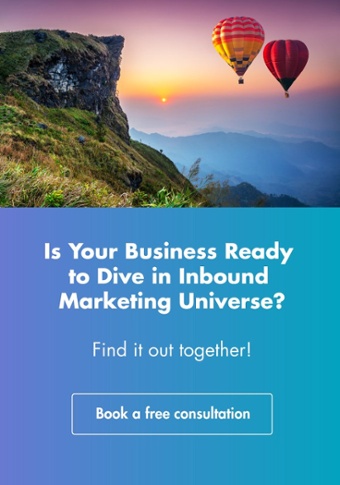Whether you’re a small business owner or a marketer for a global enterprise, having a digital marketing plan in place is essential in today’s digitally-driven world. That being said, 90% of sales and marketing professionals admit that—when it comes to marketing—there are several disconnects across strategy, process, content, and culture.
Digital marketing is the key to how businesses present and market themselves online. It includes various strategies including inbound marketing, local marketing, SEO, and social media. Without a digital marketing plan in place, your business doesn’t have a clear road-map to increased brand awareness, lead generation, and annual growth.
Creating a digital marketing plan straight off the bat can be challenging. Where do you even start? We’ve created this five-step guide to help you develop a digital marketing plan that drives results. Let’s get started.
5 Steps to Develop Your Own Digital Marketing Strategy
Whether you’re developing a digital marketing strategy for the first time or reviewing the plan you already have in place, these five simple steps can help you to define a plan that gives a sense of direction to your company and its marketing team.
1. Analyze your situation.
Before you dive into executing a marketing plan, it’s a good idea to take a step back and get a birds-eye-view of your current situation.
This means understanding what your strengths and weaknesses are, as well as identifying potential opportunities and threats that might impact your success. A great place to start is by conducting a SWOT analysis of your business, which will set the stage for creating your marketing plan.
In the modern business world, competition is fierce. Audiences are more segmented than ever before, so you need to have a comprehensive understanding of the niche your business fits into.
Consider how your products or services are superior to those of competitors, and use this information to figure out how you’ll distinguish your offerings from others. Conducting a thorough competitor analysis will help you to understand the competition while identifying any gaps in the market that you can potentially take advantage of.
Some key questions to ask yourself at this stage of your digital marketing journey include:
- What are your strengths and weaknesses?
- What opportunities and threats are there in your target market niche?
- How do you compare to your competitors? What are you selling that makes you different?
- Are there any gaps in the market that you could fill to give yourself a competitive advantage?
Once you’ve answered these questions you’ll have a good idea about where your business is positioned in the market, as well as a clear understanding of what your audience is looking for. This brings us swiftly to step number two.

2. Define your audience.
Marketing is all about knowing your audience.
Now that you know where your business stands in relation to the wider market, it’s time to get to know your audience. You might be wondering how exactly you can get to know complete strangers? Let us introduce you to a handy concept called buyer personas.
Creating buyer personas requires you to conduct market research about the people who are most likely to be interested in your product or service. This involves answering questions that lead to a well-rounded, semi-fictional picture of who your ideal customers are. That means considering things like:
- Demographics (age, gender, location, etc).
- Job, education, and related information.
- Their online and offline behavior.
- The challenges and pitfalls they face (to better understand how your product or service can help them).
- Their goals and objectives, along with how your offering aligns with fulfilling them.
To make your life easier, we’ve created a handy buyer persona template that provides you with a simple step-by-step guide to creating your buyer personas.
Armed with this information, you can define your target audience and use it to inform your digital marketing strategies. This will help you to understand which marketing tactics to use, which social media channels you should be present on, as well as how to improve your product or service to align with your audience’s needs.
3. Set metric-driven SMART goals.
What business plan would be complete without actionable goals in place? Once you’ve got a comprehensive overview of your company’s situation and target audience, it’s time to start setting those all-important goals and objectives to give your digital marketing efforts a purpose.
What do you want your marketing plan to achieve? It’s important to remember that your goals should be SMART. SMART goals are goals that are specific, measurable, attainable, relevant, and time-bound; they should provide you with a clear road-map for achieving them.
Moreover, these goals should be measurable with key metrics relating to the focus of your digital marketing strategy. For instance, if your strategic goal is to increase Facebook shares by 20% within the next six months, you’ll want to measure social media KPIs like impressions, the share of voice, and traffic.
4. Outline your budget.
As marketers, we all dream of the magic we could make happen with unlimited marketing budgets. Unfortunately, this usually isn’t the case, and we need to ensure we’re making the best of what we’re given. Outlining your budget is an important step to take when it comes to creating your digital marketing plan, as this will allow you to better understand the scope of what you can do.
When determining your marketing tactics, ensure you take note of associated costs and any additional software you might need to implement to track data and analytics. Also, think about the resources required to execute certain tactics.
Will you need to factor in paid advertising on LinkedIn or the cost of social media marketing analytics tools? Perhaps you’ll need to take on new staff to help create the content for your content marketing strategy? Once you know what the costs involved are, you can ensure you’re being realistic about the resources and budget you have at hand.
It’s likely your digital marketing plan won’t involve a single approach. Most digital marketers split their marketing budget between content strategy (Hubspot found that companies spend, on average, 46% of their budgets on content creation!), social media, SEO, and paid advertising. Outlining your budget will enable you to maximize your marketing spend by determining cost-effective tactics that in-line with your target audience.

5. Research marketing tactics and take action.
So, you’ve identified your market situation, target audience, SMART goals, and budget—now it’s time to think about the tactics you’ll use to accomplish your marketing objectives.
Your digital marketing plan should target prospects at every stage of the buyer’s journey. This way, you leave no stone unturned. A robust digital marketing strategy should attract, engage, convert, and nurture prospects. This means businesses must incorporate a wide range of marketing tactics to maximize the potential of their digital marketing efforts. This includes everything from content creation to email marketing, to paid advertising and SEO.
When it comes to planning your tactics, be sure to incorporate the inbound marketing methodology. Effective marketing no longer aligns with traditional outbound techniques, instead, it’s all about nurturing leads and letting them come to you. When businesses internalize the inbound methodology, they build long-lasting, trusting relationships with customers—which is great for business.
A successful inbound strategy revolves around creating different types of relevant and personalized content and sharing it with prospects and customers to provide value. It also involves using keyword research to make sure your content is reaching the right people on search engines, as well as planning it with an editorial calendar to align your strategy with long-term business goals.
You should also consider using marketing automation tools like Hubspot marketing software to streamline your marketing workflows and make your job easier.
Automating marketing campaigns allows you to maximize your marketing spend, reach targets in the right place and at the right time, and get analytical insights into your campaign performance. Then, marketers can leverage advanced data and analytics to understand the impact of their efforts and identify future areas of improvement.
Some key things to remember when defining your tactics:
- Ensure the content you share with your audience is valuable and relevant. Don’t waste their time.
- 93% of all online interactions begin with a search engine, which is why an effective SEO strategy is invaluable to organic growth, brand visibility, and the success of your content strategy.
- Take advantage of the global social media obsession and ensure you’re promoting your content across your social media channels too. This allows your audience to engage with you directly.
- Whatever your business goals, you should ensure you’re reaching your audience and providing value at each stage of their customer journey: awareness, consideration, and decision.
After all this, you’re ready to start executing a digital marketing strategy that drives results and helps you to achieve your business goals.
Never Stop Improving
The hard work doesn’t stop once you’ve followed these five steps and created your digital marketing plan.
Remember, there’s always room for improvement. You must continue to reevaluate your marketing plan, identifying areas that can be refined and revamped as you go along. Using data and analytics gleaned from marketing software or tools, you can understand the impact your efforts are having and identify any areas for improvement or future opportunities.
It’s also important to keep up with digital trends to ensure you’re always up to date with where your audience is hanging out online and how they’re searching. This way, you can retain a competitive advantage and remain relevant to your prospects and customers.
Want to know more about developing a digital marketing plan that drives results? Maybe you just need a nudge in the right direction to get started? We can help. Book a free consultation today.

